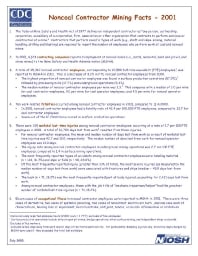Mining Publication: Noncoal Contractor Mining Facts - 2001
Original creation date: July 2003
Authors: National Institute for Occupational Safety and Health
The Federal Mine Safety and Health Act of 1977 defines an independent contractor as "any person, partnership, corporation, subsidiary of a corporation, firm, association or other organization that contracts to perform services or construction at a mine." Contractors that perform specific types of work (e.g., shaft and slope sinking, material handling, drilling and blasting) are required to report the number of employees who perform work at coal and noncoal mines. 2. In 2001, 4,123 contracting companies reported employment at noncoal mines (i.e., metal, nonmetal, sand and gravel, and stone mines) to the Mine Safety and Health Administration (MSHA). 3. A total of 45,367 noncoal contractor employees, corresponding to 23,580 full-time equivalent (FTE) employees, was reported to MSHA in 2001. This is a decrease of 8.2% in FTE noncoal contractor employees from 2000. The highest proportion of noncoal contractor employees was found in surface production operations (57.0%), followed by processing mills (37.7%) and underground operations (5.3%). The median number of noncoal contractor employees per mine was 3.3. This compares with a median of 3.0 per mine for coal contractor employees, 9.0 per mine for coal operator employees, and 4.5 per mine for noncoal operator employees. 4. Ten work-related fatalities occurred among noncoal contractor employees in 2001, compared to 11 in 2000. In 2001, noncoal contractor employees had a fatality rate of 42.4 per 100,000 FTE employees, compared to 32.7 for coal contractor employees. Seven out of the 10 fatalities occurred in surface production operations. 5. There were 391 nonfatal lost-time injuries among noncoal contractor employees, occurring at a rate of 1.7 per 100 FTE employees in 2001. A total of 16,703 days lost from work resulted from these injuries. For noncoal contractor employees, the mean and median number of days lost from work as a result of nonfatal lost-time injuries was 42.7 and 13.0, respectively. The median number of days lost from work for noncoal operator employees was 13.0 days. The injury rate among noncoal contractor employees in underground mining operations was 2.7 per 100 FTE employees, compared to 1.4 in surface mining operations. The most frequently reported types of accidents among noncoal contractor employees were handling material (n = 124, 31.7%) and slips or falls (n = 90, 23.0%). Of the most frequently reported injury (greater than 10% of total), the most severe injuries (as measured by the median number of days lost from work) were associated with fractures and chips (median = 45.0 days lost from work). The back (n = 71, 18.2%) was the most frequently reported part of body injured, accounting for 2,421 days lost from work. Among noncoal contractor employees, those with the job title of "mechanic/repairman/helper" had the greatest number of nonfatal lost-time injuries (n = 71, 18.2%). 6. Eleven cases of occupational illness in noncoal contractor employees were reported to MSHA in 2001. There were three cases of dermatitis, two cases of systemic poisoning, two cases of noncontact electric arc burn , and one case each of chemical burn, hearing loss or impairment, heat/sunstroke, and joint, tendon, or muscle inflammation or irritations.

- Coal and metal/nonmetal mining facts - 2008
- Coal and Metal/Nonmetal Mining Facts - 2008 (HTML)
- Coal Contractor Mining Facts - 2001
- Coal Contractor Mining Facts - 2002
- Coal Contractor Mining Facts - 2003
- Coal Contractor Mining Facts - 2004
- Coal Contractor Mining Facts - 2005
- Coal Contractor Mining Facts - 2006
- Mining Fact Sheets
- Rib Falls: A Major Ground Control Issue